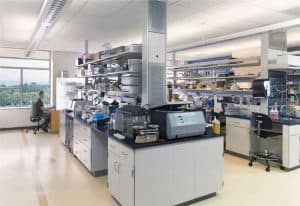by Daniel Herzig Jr.
As part of BVH’s efforts to reduce our clients’ operating costs, improve energy efficiency, and lower our collective footprint, the firm is committed to greening the practices in our laboratory designs. Labs have traditionally consumed 10 times the energy of an office facility of equal size. One of the reasons labs are so energy-intensive is that the importance of researcher safety and the necessity of the research itself have put energy usage on a lower rung of the priority ladder when designing and constructing such facilities. The recent focus on the importance of reducing our carbon footprint has brought energy consumption of labs and research sectors to the forefront of consciousness.
This awareness now coincides with technical advancements that make true energy savings possible without compromising safety. Digital control systems, for example, are now sophisticated enough to allow for energy savings on laboratory air volume, which must be heated and cooled 24 hours a day, 365 days a year. Actual realized savings in energy costs can range between 25% and 40% over traditional systems.
An additional 10% investment in laboratory mechanical systems can yield proportionally larger energy savings that can have simple paybacks of five to 10 years. Many technologies can be employed to capture these savings. Some of the more common technologies include variable-volume hoods, low-flow hoods, occupancy monitoring, and glycol run-around loops. A selection of some less common applications that have the potential to increase savings include:
• Chilled beams. This technology is a 1960’s vintage approach that has been revitalized with modern manufacturing and control approaches. When applied to laboratories, total air flow delivered can be reduced by 50% to 65%. Chilled beams work especially well in labs with low “hood densities” (fewer hoods per researcher), and labs where stricter sash management can be employed.
• Air-quality monitoring. Continuous air-quality monitoring can drastically reduce annual energy usage by providing higher levels of air flow only when contaminants are actually present. Given the low percentage of a spill, air flows can be reduced from the traditional eight to 10 air changes per hour to four air changes per hour when the laboratory is occupied, and even to two air changes per hour when unoccupied.
• Variable geometry discharge. Much of the energy used by laboratories is the electricity required to run fans at all times. Fans are typically run at or near their full capacity in order to get any potentially harmful effluent up and away from the building. By employing parabolic dampers that act as a nozzle, the fumes can be jetted up and away from the building, even at lower volumes. This allows for fan systems to be slowed down to better match the demand of the facility, having a drastic effect on electricity draw.
Saving energy no longer has to be, nor is it often permitted to be, a low-priority issue when designing and constructing a laboratory. The benefits and paybacks of many of today’s technologies make the incorporation of energy-saving measures considerably easier than it has been in the past. Their potential long-term effects on energy consumption and lower operating costs can be in harmony with the important research conducted in our laboratories and the safety of the personnel we are charged with protecting. Properly selected measures are a benefit all around.
Daniel Herzig Jr., PE, is the vice president of BVH.









